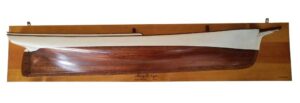

UNDERSTANDING HALF-HULL MODELS
by Land And Sea Collection™![]()
![]()

Half Hull “Mary B. Dyer” – Ship Design by Donald McKay
![]()
If you are considering investing in an authentic shipbuilder’s half hull,
these are some things you should know. When you are done reading, you may want to view our current vintage
and antique half-hull models.
https://landandseacollection.com/id300.html
Antique
builders model of a coal collier, 47 1/2″ L x 10 1/4″ H x 6″ W, Ca 1890,
There are a number of different types
of authentic half hulls, all of which had different uses and applications. It is helpful in evaluating a half hull to be aware
of their use so they may be compared to others of the same type, and contemporary reproductions. Many of the models
in this section, unless otherwise noted, have been sold.
BUILDERS CONSTRUCTION HALF HULL: This type of model was made to establish the shape of the vessel, and was constructed out of a series of planks called “lifts” which were joined
together using dowels prior to 1820, or by screws afterward. When disassembled, the individual lifts were laid on the floor
and expanded to full size in a process called “lofting”. From these shapes, timbers were cut, and frames and strakes were assembled
to build the full-size vessel.
Builder’s construction models are rare, old, varnished rather
than painted, and devoid of detail. They are one-off, large rather than medium to small size, and they always can be taken
apart. If the name of the vessel is known, its value is greater. The varnished wood has generally mellowed with age and
has a rich dark patina. Their value increases with the prominence of the vessel if known, the size of the hull, and of course,
most important, its condition.
Builder’s construction plating models were used to lay out the location
of the ship’s plating when construction changed from wood to iron and then to steel. What is confusing is there are various types of
BUILDER’S MODELS which don’t have all those characteristics. Builder’s DISPLAY
MODELS don’t come apart but were made by builders, either to present to the ship owners or to be used as displays of
completed ships in the builder’s offices or at trade shows for sales promotion. Consequently. they may be done in much greater
detail, and have painted hulls and other embellishments that make them more visually appealing. Models of merchant ships enclosed
in glass cases can sell for $15000.00 and more.
BUILDER’S
PRESENTATION HALF MODELS: were made to be given as gifts to the party contracting for the vessel such as a steamship
company, yacht owner, government, etc. They also were used at trade shows and in the builder’s office to demonstrate their
capabilities and as a visual record of the ships, they had built.
The example in this listing and this half hull of the SS OITHONA have all the
characteristics of a true builder’s presentation model.
Builder’s Model S.S. Oithona, above, Dated
1850, 60″ L x 11 3/4″ H x 4″ W, Served in Australian Trade and was sold to a buyer in New Zealand.
This example is of an authentic builder’s construction model of the Schooner
Mermaid. It was made by its master builder and handed down in his family in an unfinished
state. After much deliberation, our shop finished it as he would have done.
Builder’s Half Hull Model of Large Sailing Ship
Mermaid above after sanding, but yet unfinished, 44″ x 10″; Ca 1900; Handed down in maker’s family
This one looks like a builders plating model of
the Iron Ship VIXEN, but was made by an English artesian in the 1950s and is a reproduction.
Plating
Half Hull Model of Clipper Ship VIXEN, 20th Cent, 45″ x 10″
This one is
an authentic builder’s plating half hull of an unidentified cargo ship likely dating to around 1900.

